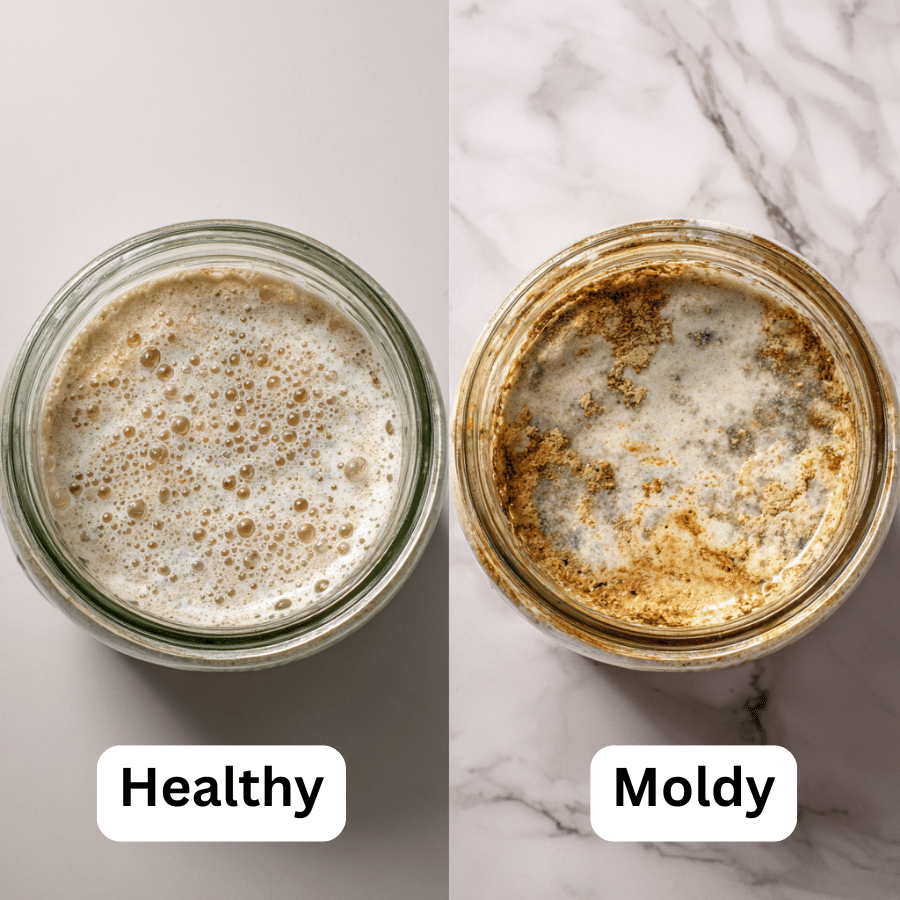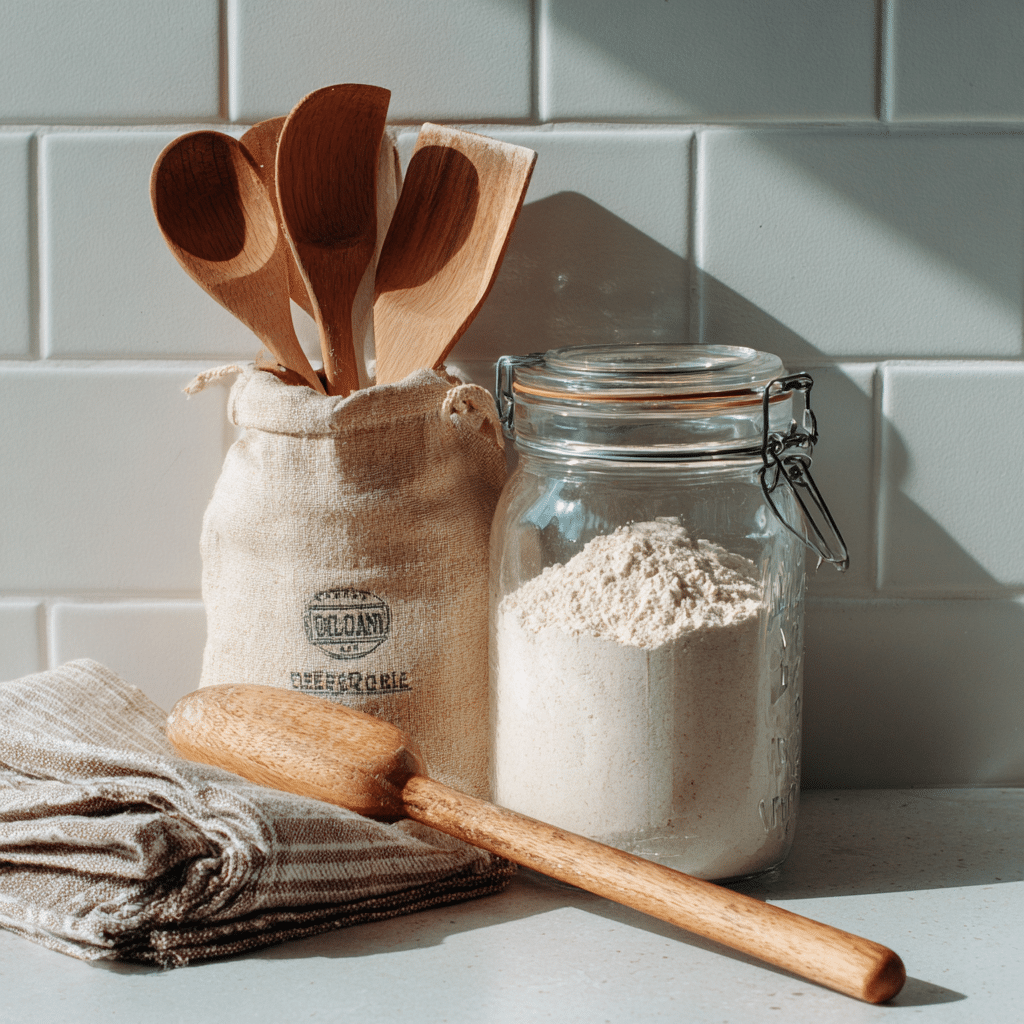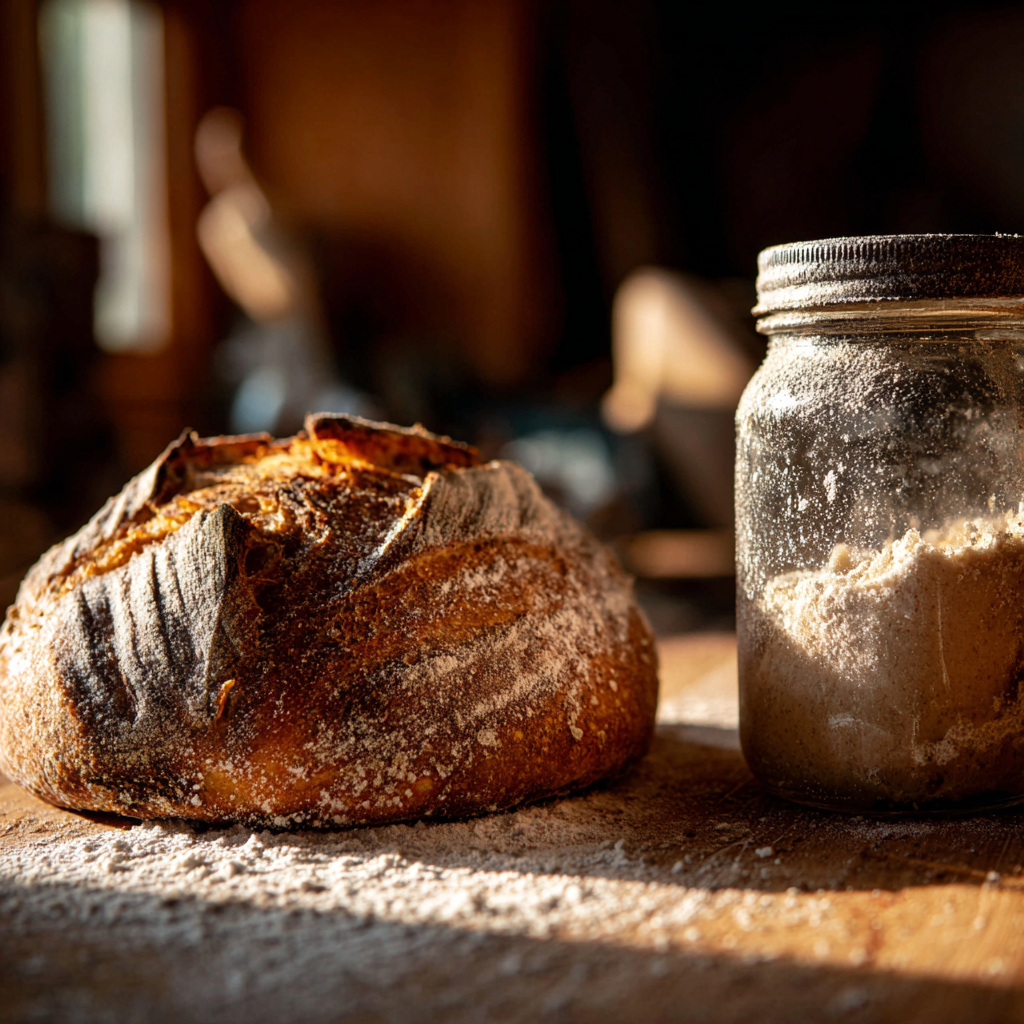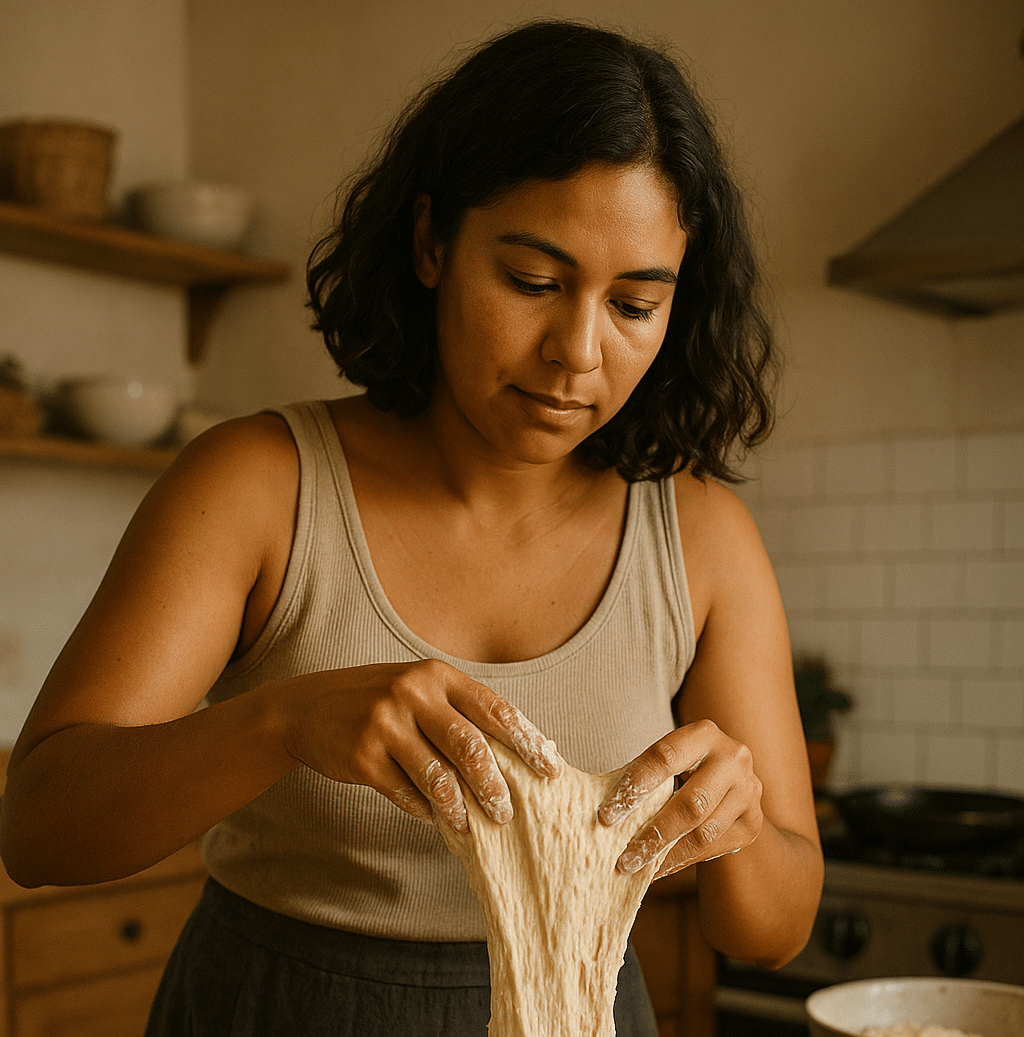You’ve opened the lid. There’s something questionable on top. Is it just hooch—or is your sourdough starter moldy? If you’ve found yourself googling “moldy sourdough starter” with a mix of panic and hope, you’re not alone. This article will guide you through what mold looks like, what’s salvageable, and when it’s time to say goodbye. We’ll explore how to spot, prevent, and recover from mold so you can get back to baking with confidence. Whether your jar smells weird, looks off, or you’re just unsure, we’ll help you figure it out—no guessing necessary.
Table of Contents
Moldy Sourdough Starter Warning: Spot the Signs & Save Your Bake
Spotting Real Mold vs. Normal Funk

My journey with sourdough didn’t start perfectly. Like many beginners, I once mistook a layer of hooch for mold and tossed a perfectly good starter. That was a painful lesson, but a helpful one. A moldy sourdough starter looks very different from one that’s just tired or hungry. Mold appears as fuzzy spots—white, green, black, or even pink—typically on the surface or around the jar’s edges. If you notice anything with texture, color variation, or spreading growth, don’t feed it—scrap it.
Many confuse a dark liquid layer (hooch) or a slightly gray tone with mold. These are normal. What’s not normal? Bright colored growth, off-smells like cheese gone wrong, or anything that looks furry. If it looks like something from the back of your fridge, trust your instincts—it’s likely a moldy sourdough starter that needs to go.
Internal reference: If you’ve been keeping your starter near your sourdough discard stash, remember to check how to safely repurpose it with tips from our cinnamon roll bites recipe, which also explains safe discard behavior.
When Mold Means It’s Time to Toss It
It can be heartbreaking, but some starters just can’t be saved. If the mold is floating on the surface, discolored the starter beneath, or spread around the inner jar rim, it’s time to toss the whole thing. Even scraping off the top won’t guarantee safety, as mold spores penetrate deeper. Once you’ve identified a moldy sourdough starter, it’s safer to start fresh.
The good news? If you’ve ever successfully made sourdough bread without starter, you know that rebuilding is possible. Starting over can be empowering—and often easier than trying to rehabilitate a compromised culture.
Internal tip: For a fresh start, read our guide on maintaining airy structure like in our ciabatta sourdough recipe, which includes tips on starter care.
Why Moldy Sourdough Starter Happens and How to Prevent It

What Causes Mold in Your Sourdough Starter?
Let’s be honest—no one sets out to grow a moldy sourdough starter, but sometimes the smallest misstep invites the wrong kind of microbial party. Mold loves moisture, warmth, and food—all the things a sourdough jar offers in abundance. One of the biggest culprits? Poor jar hygiene. If your container wasn’t thoroughly clean when you began or if you’re using a lid that traps too much humidity, you’re giving mold a free ticket to settle in.
Another common cause is infrequent feeding. A neglected starter, especially one left too long at room temperature, can acidify unevenly, creating the perfect breeding ground for mold. If you see something odd growing just days after feeding, it’s likely a result of leftover food residue or an environment that was simply too warm.
External contaminants are another issue. Cross-contamination from utensils, hands, or nearby ferments can introduce rogue spores. If your starter lives near compost, fruit bowls, or even plants, it might be exposed to airborne mold spores.
Internal link: Our starter-free sourdough method shows how to reduce risks by streamlining the fermentation process with safer conditions.
Tips to Keep Your Sourdough Starter Mold-Free
Prevention is the best defense when it comes to a moldy sourdough starter. Start with clean tools and a sterilized jar—boiling water or vinegar rinses can work wonders. Avoid airtight lids; your starter needs to breathe. A loose cover like a coffee filter or cloth secured with a rubber band allows airflow without inviting contamination.
Feeding regularly is also crucial. A healthy feeding schedule (every 12–24 hours at room temp, or once a week in the fridge) keeps the starter acidic enough to resist mold growth. If your kitchen is especially warm, consider cold-storing your starter between bakes.
Location matters too. Store your jar away from other ferments, garbage bins, and fruit—especially bananas, which release ethylene gas and can encourage spoilage. Keep it somewhere with stable temperature and low humidity.
Internal link: For safe fermentation and beautiful texture, take inspiration from our sourdough ciabatta guide, which includes feeding and hydration notes that double as mold-prevention tips.
Can a Moldy Sourdough Starter Still Rise?
The Myth of “Scraping It Off”
We’ve all seen it in baking forums—someone suggests scraping off the moldy bits and continuing as if nothing happened. But when it comes to a moldy sourdough starter, rising doesn’t equal safety. Yes, your starter might still bubble and grow after a feeding. That doesn’t mean it’s okay to use.
Mold doesn’t just stay on the surface. Once it’s visible, microscopic spores are often already dispersed throughout the jar. Even if it smells fine or rises normally, the microbial balance is off. Some strains of mold produce harmful mycotoxins, especially in warm, moist environments. These toxins don’t always change the smell or color, but they don’t belong anywhere near your bread.
It’s better to discard and start fresh than to gamble with invisible risks.
Internal link: If you’re starting over, it’s a great opportunity to test your skills with a clean slate—try our easy sourdough no-discard loaf while you rebuild your new starter safely.
Rising Doesn’t Mean Recovery
It’s true that yeast, which causes rising, can still be active in a contaminated starter. But that doesn’t mean the beneficial bacteria (lactobacillus) are healthy—or that the balance between them is right. In a moldy sourdough starter, wild yeast might continue to do its job for a while, but the flavor, structure, and safety of your bread will suffer.
What’s more, if you bake regularly, a moldy starter can compromise everything else in your kitchen. It can contaminate nearby jars, utensils, or your proofing basket. Mold spores are sneaky. The better option is a clean break and a fresh beginning.
Internal link: If this feels like a setback, remember every baker faces it. Our post on sourdough discard cinnamon rolls is a reminder that even mistakes can lead to something sweet.
How to Tell If Your Sourdough Starter Has Gone Bad
Use Your Senses to Check Starter Health
Wondering if it’s time to toss your sourdough starter? Let your eyes, nose, and instincts guide you. A strong, active starter will look bubbly and smell pleasantly tangy. But when things go off, the signs are usually clear.
Mold can show up as fuzzy patches in colors like green, pink, or black. If you spot anything textured and colorful, it’s time to start fresh. Smell is just as telling—sharp notes like rotten cheese, ammonia, or nail polish usually indicate deeper issues. And if your starter feels unusually slimy or stringy, that’s another red flag.
If you’re unsure, refer to the chart below for quick answers.
Quick Guide to Starter Health
Here’s a simple reference chart to help you spot issues fast:
| Sign | What It Means |
|---|---|
| Rises well after feeding | Starter is active and healthy |
| Gray or clear liquid on top | This is hooch—feed and stir |
| Fuzzy pink, green, or black patches | Mold—discard immediately |
| Smells like ammonia or rot | Likely spoiled and unsafe |
| Sticky or stringy texture | Unbalanced microbes—start over |
When in doubt, don’t risk your health. Toss the jar and begin again with a clean container and fresh flour. It’s better to start new than bake with something questionable.
Frequently Asked Questions About Moldy Sourdough Starter
What does moldy sourdough starter look like?
A moldy sourdough starter will often show fuzzy patches or spots in colors like green, black, pink, or orange. Unlike hooch, which is a harmless liquid that sits on top, mold has texture and usually appears around the jar’s rim or directly on the surface. If it looks fuzzy or colorful, it’s not safe to use.
Is my sourdough starter moldy?
If you’re not sure, check three things: color, smell, and surface texture. Mold is never smooth—it grows in blotches and has an earthy, musty, or rotten scent. A layer of hooch or slight grayness is fine, but fuzz or odd colors are warning signs. When in doubt, toss it out.
Will moldy sourdough starter still rise?
Surprisingly, yes—it might. But that doesn’t mean it’s safe to use. Yeast can remain active even when mold has taken hold. A starter that still rises but shows signs of contamination is not reliable or safe for baking. Always prioritize safety over saving a batch.
How can you tell if sourdough starter is bad?
Look for unusual smells (ammonia, rotten cheese), slime-like texture, or colored mold spots. If your starter refuses to rise even after consistent feedings, that’s another red flag. A healthy culture should double in size within 4–6 hours of feeding at room temperature.
Internal link: For more insight into feeding times and rise behavior, you can refer to the visual cues in our ciabatta bread recipe.
Conclusion: Don’t Let Mold Stop Your Sourdough Journey

Every sourdough baker—new or seasoned—runs into a jar that looks a little… questionable. Spotting a moldy sourdough starter can feel discouraging, especially after days or weeks of nurturing it. But here’s the good news: it’s completely normal, and it doesn’t mean you’ve failed.
Mold is usually a sign that something in the process needs adjusting—whether it’s feeding frequency, jar hygiene, or storage temperature. Now that you know what to look for and how to respond, you can confidently decide when to feed, when to restart, and when to bake your next crusty loaf.
And remember, every time you begin again, you’re not starting over—you’re starting smarter.
Internal link: While your new starter takes shape, keep your oven warm with our sourdough discard cinnamon rolls—a sweet reminder that nothing is wasted in the world of wild fermentation.






